Genesis from Another World: the Sega System C
There’s a concept called the “Uncanny Valley”; when a human looks at a cartoonish face, they’ll generally recognize it as a person. When they’re presented with a photorealistic face, they’ll similarly recognize it. But when presented with an image that is highly realistic but just a bit “off”, the human will tend to find it repulsive or disturbing. Today, we’ll take a look at yet another Sega arcade board: one that would trigger an “uncanny valley” reaction in a Sega Genesis, if you gave it a human brain.
Console-based arcade machines
A great thing about having a lot of posts is that I can link back to them easily. However, since my fancy tends to wander around uncontrollably, they end up a bit out of order. Such is the case here. One of my first posts in this arcade obsession was the Sammy Atomiswave.
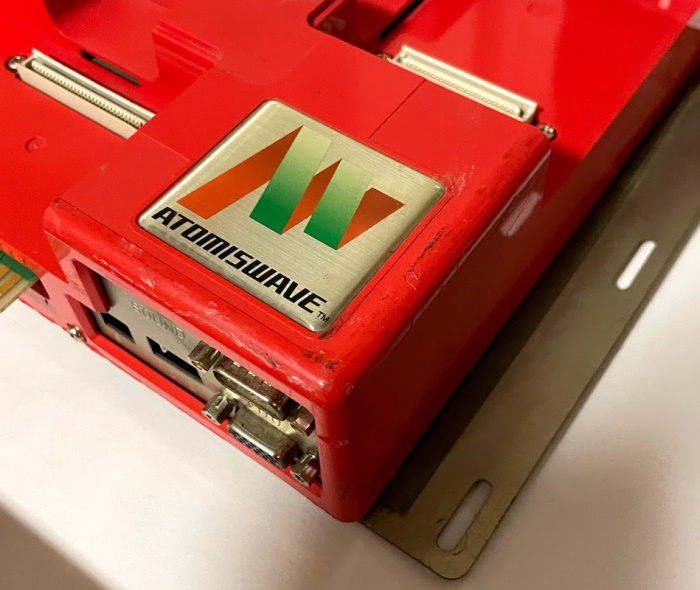
An interesting thing about the Atomiswave is that it was, essentially, a Sega Dreamcast that took cartridges instead of GD-ROMs. Unlike the Sega NAOMI, it shared identical specs with the consumer machine, despite coming out after the Dreamcast’s 2001 discontinuation.
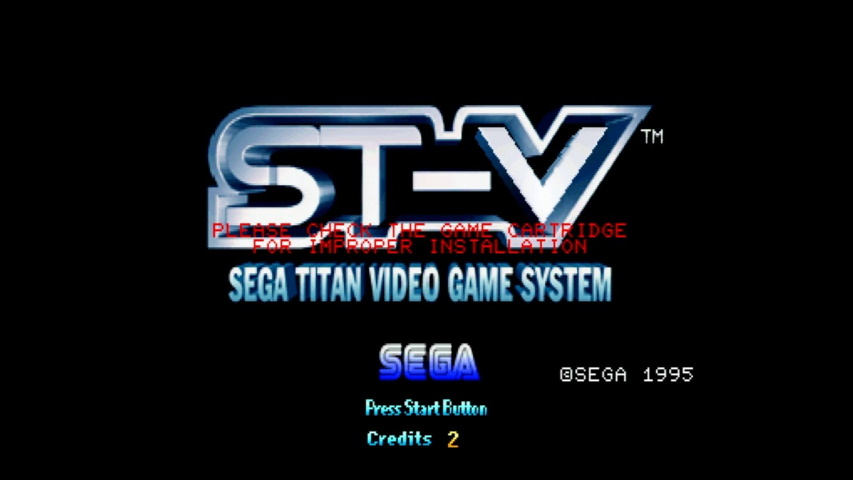
I also talked about the Sega ST-V. This was also a Sega arcade board that used cartridges, which was based off of consumer hardware that used optical discs. In this case, it was based off of the 32-bit Saturn console.
Well, we continue our journey back in time today.
The System C
The System 1, which I have covered relentlessly, basically reached the end of its life in 1986. Its last title, Vic Tokai’s 1987 Block Gal, took Sega’s former flagship hardware and used it solely as a vehicle for uncovering some pictures of cute girls. There’s nothing wrong with pictures of cute girls, of course. But it was time for something new.
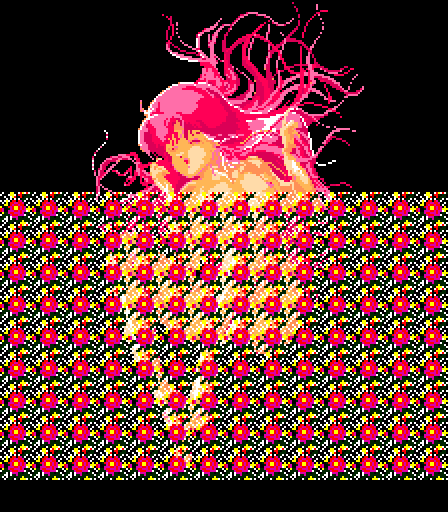
The System 2, a System 1 with a superior scrolling tilemap, lasted a few more years, and Vic Tokai never got their hands on it. But by 1988, when its last game, UFO Senshi Youko Chan, was released, there was a problem. See, in 1988, Sega also released their 16-bit Mega Drive console in Japan; and pretty much the only thing the System 2 has over the Mega Drive is the number of possible simultaneous on-screen colors. Plus, the System 2 was poorly suited to a low-end arcade board, with its large daughterboard and huge amount of discrete logic.

Behold, the solution to those problems: the System C. It’s an adorable little board; and like the Sega System 1 before it, these are single-game boards, without any interchangeable cartridges. Compare it to the System 1 (in this case, the Teddy Boy Blues bootleg), and you can see that it really is a quite small. Plus Sega gave it a JAMMA edge connector this time! I know the System 1 predated the standard so I can’t blame them, but standards are nice.
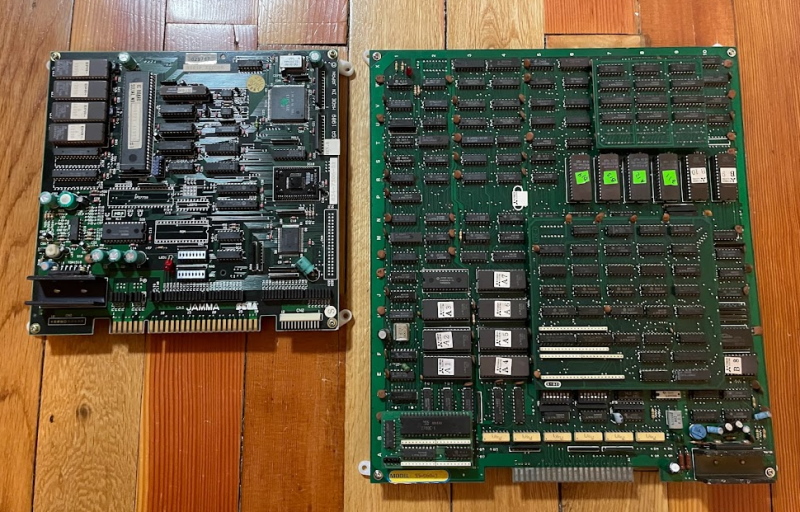
This is made possible by sharing the same VDP (Video Display Processor) that powers the Sega Genesis. Here, it’s labeled Sega 315-5313 (you might also see it referred to as Yamaha YM7101), and judging by the photos on the Mega Drive Development Wiki, it’s an early revision. That fits; this board is dated 1989, which is definitely early for the Mega Drive.
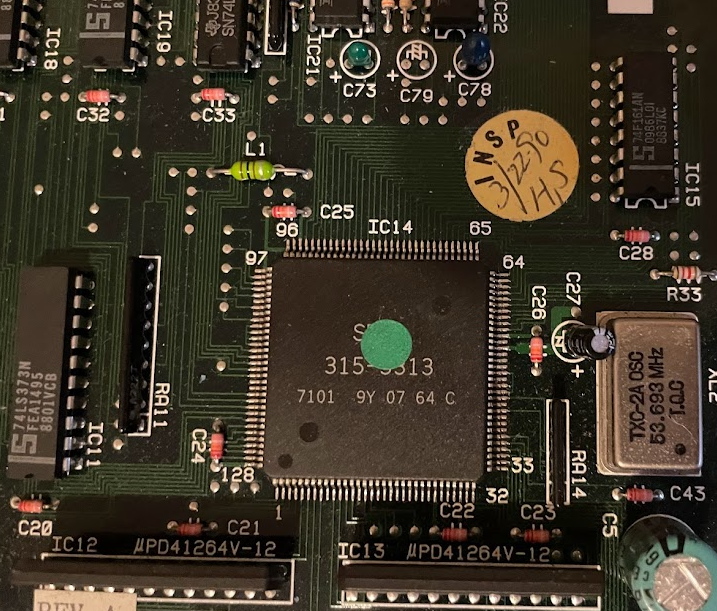
The 315-5313 is a truly integrated circuit; it doesn’t just contain the video processor, but also a “Sega PSG”, a clone of the 4-channel TI SN76489 found essentially all over the machines of the 1980’s. If they had wanted to, Sega could’ve paired this with just a CPU and called it a day; Atari probably would have. Thankfully, they instead paired it with a Yamaha FM synthesizer. On the Genesis model 1, this was the Yamaha YM2612.
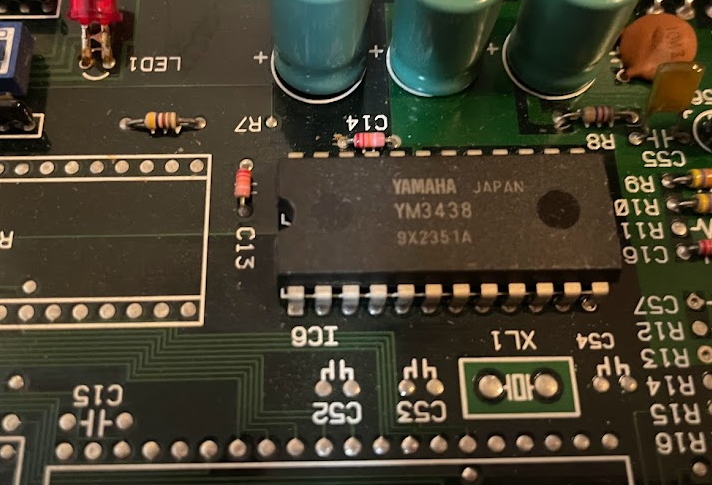
This is where the “uncanny valley” starts to set in. The System C board uses a Yamaha YM3438. Despite the differing number, this is just a CMOS variant of the YM2612; comparable to perhaps the MOS 6502 vs. the WDC 65C02. A different chip manufacturing process, some minor incompatibilities (in this case, this includes the audio output impedance), but if you’re not doing anything too weird switching between them shouldn’t be too difficult. In fact, later Genesis models included a core based off the YM3438, but only as part of wider integrated circuits that also included the VDP.
So it’s not exactly wrong. Just a little weird if you’re used to the Genesis.
An aside of sound
This board is a “System C” board, as I’ve noted. But most games released for this platform were “System C2”. What’s the difference? An NEC uPD7759 ADPCM sample playback chip, which has its own ROM. This is a fairly nice upgrade, and high quality voices in arcade games were still a novelty at the time. Interestingly, though, even though this 1989 board predates the first System C2 games in 1990, it already has space on the board, so this upgrade was clearly planned from early on.

Where are my colors
Some more fun sets in when we look at the odd potted circuitboard masquerading as a chip, the Sega 315-5242. What does this do?

It turns out that this part has a long history in Sega boards, it’s generally referred to as a “color encoder”. And what it does here, we’ll have to look back at the Genesis. The Sega Genesis was an excellent console capable of amazing things, but even the most hardcore dithering afficionado will agree that its Achilles’ heel was the color palette.
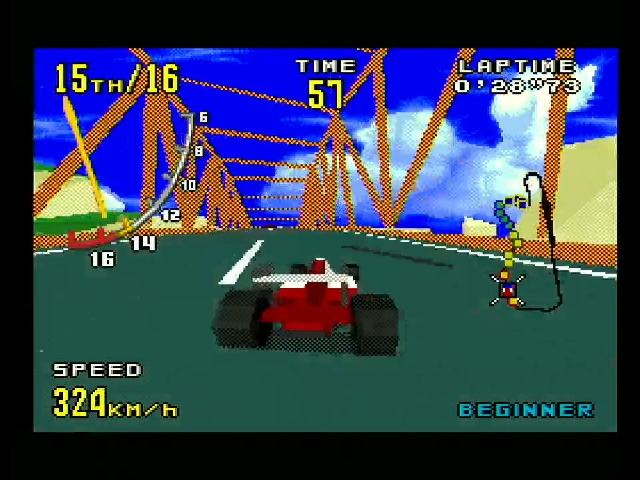
The Genesis VDP has 64 internal 9-bit words for 64 RGB colors. These are divided into four 16-color palettes, the first color of which is transparent, so in reality, the Genesis can only have 61 colors on screen. (Shadow and highlight modes, plus timing tricks can improve this) By comparison, the PC Engine’s Video Color Encoder (VCE) has internal palette RAM with room for 512 9-bit words.
The 315-5242 is used to bypass the internal color encoder and the internal palette RAM of the Genesis VDP. Instead, it has its own color RAM of 4 banks of 1024 bytes. It uses 15-bit colors in 16-bit words, so 512 simultaneous colors, 32 simultaneous 16-color palettes. And as noted, the 315-5242 color encoder was used on many Sega arcade boards, so this was a fairly straightforward way to shine up the consumer-spec VDP for the System C.
The analog video outputs are not used on the Genesis VDP, and instead an 8-bit “color bus” is used to send each pixel to the color encoder circuit. This bus provides the 4-bit palette index of the current pixel, 2 palette select bits (for the usual four Genesis palettes), a bit to indictate whether the shadow or highlight effect is being used (but not which one), and a bit to indicate sprites or backgrounds. (Source: Charles MacDonald’s System C2 hardware notes) Because this only allows for 256 possible colors, and fewer when you consider that the shadow/highlight are not well-defined on this bus, the additional bits are controlled by the Sega 317-xxxx game-specific protection chip.
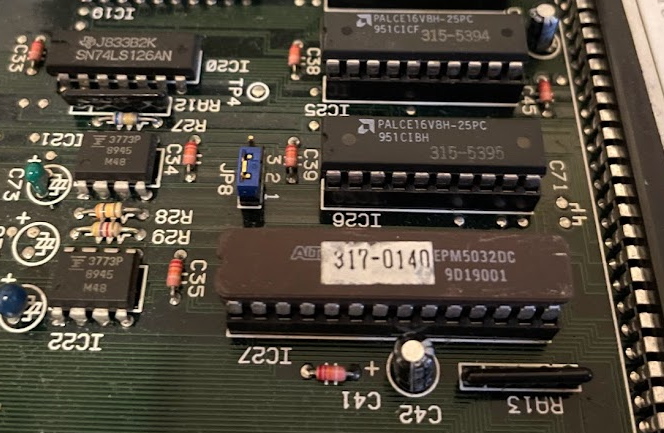
This chip is actually an Altera EPM5032 FPGA, which is what allows it to be swapped out for each game. FPGAs are not new technology, though this one is definitely too small to run a MiSTer core. Using a different FPGA for each game means that I can’t just rewrite some EPROMs to convert this game to a different System C board; I’d have to buy an official kit from Sega. (Well, ideally for them anyway)
In practice, the biggest visual differences seem to be from the use of 15-bit color rather than 9-bit RGB color. Compare the screenshots of the Sega CD version of Columns with the arcade System C release. The System C used much subtler colors. (Of course, being on a system where you were guaranteed to have a high quality RGB arcade monitor, vs. a fuzzy RF connection, also helped)

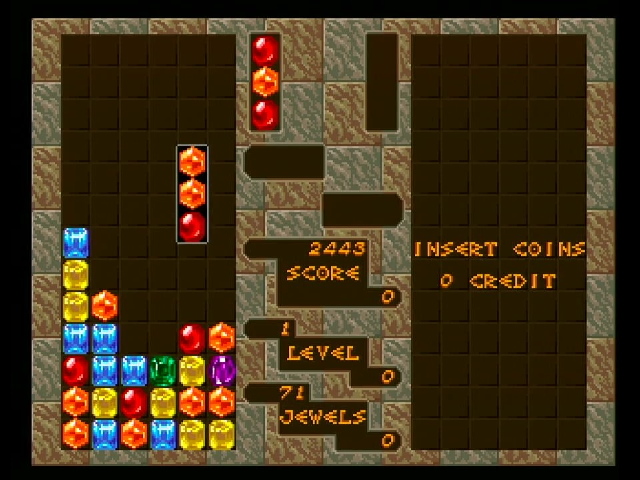
Achieving perfection
Perfection is achieved, not when there is nothing more to add, but when there is nothing left to take away. — Antoine de Saint-Exupéry
We’ve talked about extra chips that the System C has over its Genesis base. However, there is something quite notable missing from the circuitboard: the Zilog Z80 coprocessor. And no, it’s not integrated in the VDP, as it would be on later Genesis models. It’s gone entirely here.
Why would they remove the Z80? Well, the first reason the Z80 is there is because of the need for backwards compatibility. Sega of course had no need to run Master System games on its Genesis-based arcade boards.
The other role the Z80 plays is as an audio co-processor. In many games, the Z80 handles audio resources. But this isn’t always so clear-cut. We have, through the painstaking efforts of fans, disassemblies for some major Genesis games. Compare the Z80 sound driver code of Sonic the Hedgehog 2 and that of Sonic the Hedgehog. Even if you don’t understand a bit of Z80 ASM, you’ll see that the Sonic 2 one is much longer. That’s because most of Sonic 1’s sound driver runs on the 68000 CPU, with the Z80 only used for feeding in samples with exact timing. (And of course, the System C2 would add a dedicated sample chip, so no need for that) Sonic 2, meanwhile, does make much greater use of the Z80, freeing more 68k time for the game.
The other reason the System C can get away with this is because it has a faster Motorola 68000. On the Genesis the 68k is clocked at 7.67MHz; on the System C, that is increased to 8.95MHz. (I’m going to only use NTSC numbers here) Sega Retro claims the Genesis 68k can do 1.34 MIPS (millions of instructions per second); assuming that scales linearly with clock speed (and it should), the System C can do 1.56 MIPS. This doesn’t wholly compensate for the 0.52 MIPS Sega Retro attributes to the Z80, but it does remove the overhead of needing to communicate between processors. In any case, the System C games didn’t tend to be speed demons. Sega had other boards to push the edge of technology.
Bloxeed
So, a Genesis with souped-up colors, a sped-up CPU, an ever-so-slightly different sound chip, and no Z80. That’s all well and good, but what does it play?
The System C’s lineup is very heavy on one genre: falling-block puzzles. This is the system with Columns, with Puyo Puyo, and with lesser-known ones like Poto Poto. These definitely aren’t the only style of games that were released (notably, Thunder Force AC, a port of the Genesis shooter Thunder Force III, used the System C2) But why not have a lot of falling block games? Alexey Pajnitov’s Tetris is practically the closest thing to a perfect video game.
Sega brought Tetris to the Japanese arcades in 1988. But the Tetris rights are an absolute mess; long story short, Atari Games (Tengen) believed it had the arcade and console rights, and Sega bought a license from them to make an arcade version in Japan. Atari’s rights were not actually legitimate, and so their NES release (and Sega’s planned Genesis release) were pulled from shelves in favor of Bullet-Proof Software, who sublicensed the western console business to Nintendo. But the arcade rights were renegotiated, and so Atari and Sega were able to keep making arcade games until 1992, when Atari decided to stop paying and the licensing house of cards collapsed.

Anyway, long story short, Sega could make Tetris games in the arcade in 1989. And of course, without the need for scaling or flashy sprites, it was a good use-case for their new low-end hardware. But the arcade business thrives on novelty, and Tetris was so December 1988. How to make Tetris novel to keep the quarters flowing?

Bloxeed is, in a sense, just Tetris with some extra bits glued on. It follows the standard behaviors set about by Sega’s 1988 arcade Tetris, including having various digitzed photos as the backgrounds for the gameplay. The tetrominos are the same, along with the goal of getting lines.

There are a few main differences between Bloxeed and Tetris. For one things, Bloxeed introduces true multiplayer to the arcade. This had already been done before in other releases, but Bloxeed’s was definitely influential, with the capability of sending garbage to your opponent by clearing multiple lines at once. (I’m not sure whether Bloxeed or Nintendo’s Game Boy release of Tetris did this first)
Garbage is a constant threat in Bloxeed in a way it isn’t in other versions of Tetris. On each player’s side, you see five lights. These are a timer; when they are full, the next piece the player drops that doesn’t complete a line will result in the player getting a line of garbage added to the bottom of their side. In classic arcade style, this keeps the gameplay moving fast. But the game does give you some features to even the odds: Power Blocks.

These are special tiles that replace one of the four components of a tetromino. When a line is cleared, these have an effect. These range from “B”, a bomb that destroys blocks around it, “4”, which clears up to four randomly-selected rows, to more interesting ones. For example, “S” spawns a satellite, which you can manuever and fire lasers from as it falls downwards.

“16” creates a 16-ton weight. When dropped on the playfield, it crushes three vertical lines entirely, leaving a large hole in the playfield that can help you get out of tricky situations.

And “F” summons our good friend Flicky, the protagonist of Flicky. Flicky was definitely still a Sega mascot of sorts at this time; here, she drops single blocks onto the field wherever you wish, the opposite of the satellite. These blocks can clear lines, so she’s definitely useful.

So Bloxeed does add some fun elements to Tetris, and arguably, the extra garbage and the power blocks cancel out in a way; having extra tools makes the more aggressive elements seem less unfair, even if the whole game is now much more random. On the other hand, Tetris is a hard game to improve. Later Tetris games would have similar garbage-based multiplayer, but would remove the other innovations of Bloxeed. Like how professional players turn off the items in Super Smash Bros., I suspect Tetris afficionados prefer their game without them too.
System See-you-later
In the follow-up article to Teddy Boy Blues, I mentioned an unreleased 1992 game called SegaSonic Bros.. A falling block puzzle game, it probably won’t surprise you to hear that it would have run on the System C2 hardware.
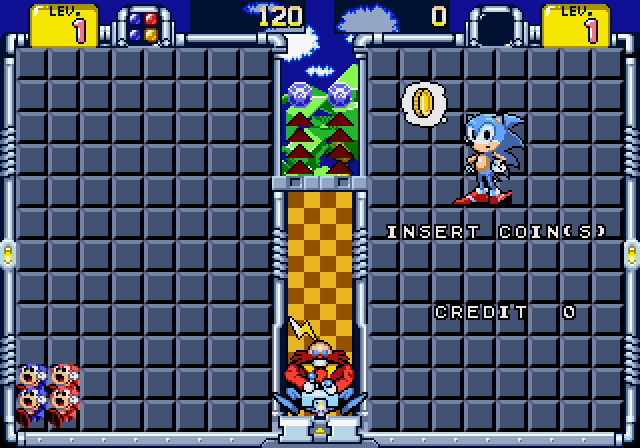
The System C software actually managed to live into the latter half of the 1990s thanks to Sega and Atlus’ Print Club series of arcade photo booths. These were sold world-wide, and were designed to let you take photos, and then print out stickers with the resulting photo and various extra graphics, almost like an arcade version of the Casio Loopy with its Magical Shop peripheral. They’d upgrade to the Sega ST-V for the follow-up, and that was the end of the System C. Not a bad run for a little low-end board.
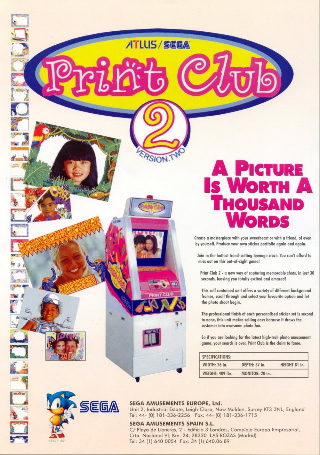
Flyer from System 16, shrunk down for fair use purposes, you can see the full size there
